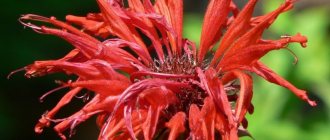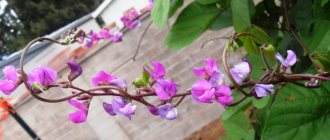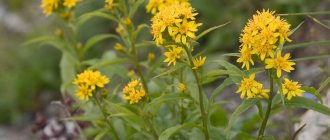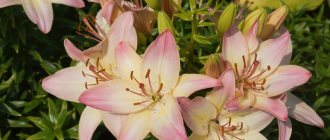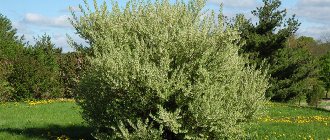Description of the plant
Speedwell is a perennial and, depending on the variety, can grow from 15 to 60 cm. The stem of the plant is strong, straight and non-branching. It is densely dotted with flowers. At the same time, the roots of Veronica are thin and grow horizontally. The size of the leaflets depends on their location on the stem, the length is from 1.5 - 8.5 cm, and the width is 0.3 - 3 cm. The edges are serrated.
It blooms with a thick brush, which is narrowed towards the top. Its length can be from 5 to 30 cm. Small flowers are held on short, hairy pedicels. The calyx consists of four oblong lobes of different lengths. The most common flowers are blue or bright blue. But the corolla can be purple, pink or white.
After flowering, Veronica spica forms rounded boxes with glandular hairs. Smooth, flat-convex, egg-shaped seeds ripen in them. Their length is 0.75 mm and width is 0.5 mm.
Flowering begins after the 10th of June and lasts about 35 days.
Veronica reproduction
Gardeners practice propagation of speedwell using cuttings or simply dividing the plant bush. With these methods of propagation, all varietal characteristics are preserved. Dividing the bush
- the most common method of propagation, especially successful when transplanting and rejuvenating perennials, which is carried out every 5-6 years.
If you need to separate part of the plant without waiting several years, you can do this earlier. The division procedure is carried out in spring (before foliage appears) or autumn (after flowering). To do this, first, all above-ground shoots are cut off, then the plant is dug up and divided into parts. Each viable part must have at least three basal shoots. If the cuttings are weak, it is better to first root them in the soil substrate, with the addition of peat and sand, and only then plant them in open ground. Digging up the plant is not difficult, given the superficial location of the roots. In addition, this method of propagation ensures faster survival and adaptation of the plant in a new place. For propagation,
apical young shoots (10 cm long) are cut by cuttings, their tops are cut off and they are lowered into water. Prepared cuttings for rooting are placed in a loose substrate of perlite and peat with sand. After successful rooting, the cuttings are planted in open ground. You can take cuttings from Veronica bushes from spring to early autumn. From the second half of autumn it is no longer worth preparing cuttings, as they will not have time to take root by winter. In summer, the planted cuttings need to be given more attention: the shoots are shaded (you can cover them with film), regular watering, ventilation and gradual adaptation to light are provided.
Decorative qualities
Veronica is a flower that has been used in culture since 1570. Today it is a good decoration in mixborders. But it is often planted as a single flower.
Veronica also looks good in rocky gardens and near hills. The flower will bloom magnificently if it is given a sunny area. If you want to combine with other plants, then it harmonizes with carnations, saxifrage, Dalmatian geranium, and sedum.
Mixborder formation
Bright, delicate Veronica flowers are collected in luxurious clusters. The stems are quite long, forming a vertical. If we also take into account the unpretentiousness of this perennial and long-term flowering in stages, we get an ideal option for a flower garden.
It is necessary to form mixborders, taking into account whimsicality, compatibility and flowering period. The composition is built around a central vertical plant, framed by lower tiers and ground covers.
Veronica flowers will look great in a mixborder with hostas and bells.
The peak flowering of the composition will occur in July. The bluebells will bloom, followed by the Veronica flowers. Later the lily will open. When it fades, Veronica will again attract attention. Then it will be the turn of the main party of hostas. It will bloom and turn green powerfully and for a long time. All this riot of colors will be supported and shaded by lungworts, heucheras and yellow foxtail.
Such a bright, fresh and unusual flower garden will be the highlight and pride of any garden all summer long.
Veronica spicata: planting and caring for the plant
You can plant this flower on your site using cuttings or by dividing the bush. The plant also grows well from seeds. It is worth noting that the flower can self-sow. Seeds are sown in open ground at the beginning of autumn, when the ground temperature is about 15 0 C to a depth of 0.5 cm. Already in the second week there are sprouts. For the plant to sprout and take root, it needs light soil with average moisture. But many gardeners note that Veronica is not so demanding of the soil in which it grows.
A plant grown from seeds can be transplanted to its permanent place next year in late summer or early September. It is good if it is a sunny area or partial shade. It is recommended to maintain a distance of 30–50 cm between each seedling. Veronica spicata blooms in the second year after sowing. An overgrown bush can be divided.
The plant does not need winter shelter, as it easily tolerates frosts in central Russia. Veronica is also drought-resistant, although if there are rainy days, it will tolerate this too. In spring, the flower is watered only if it is dry outside. It’s good if you do a little mulching around the bushes. Veronica is spicate, varieties above 60 cm need to be tied to a support.
The plant may die from severe waterlogging in winter.
How to grow a plant
Growing spiked speedwell in the garden is quite simple. The flower is unpretentious and does not require painstaking care.
The great advantage of speedwell is that it can be planted in absolutely any soil. Almost all species prefer high humidity, but drought will not harm them.
It is recommended to plant the plant in a sunny area. You should not plant a flower in the shade, but partial shade will do. Flowers are not afraid of frost either. But this does not apply to all species. It is recommended to insulate Veronica branched with spruce branches.
Veronica, like many garden flowers, needs pruning. The procedure is carried out exclusively after flowering.
Weeding should be carried out periodically, then the plant will not become overgrown with weeds and will not run wild. Also, flowers should be fed twice a season.
Simple care rules to follow:
- In spring, add a small layer of compost and about 5 centimeters of mulch. In this case, it will be difficult for weeds to hatch, and the soil will be moist.
- In summer, abundant watering is required. During drought it is increased.
- As soon as the first frost hits, the flower stems are cut off, leaving only 3-5 centimeters.
- It is recommended to plant Veronica every 3-4 years, in the spring.
With proper care, Veronica spikelet is not susceptible to pests and diseases. But spots may still appear on the leaves. In this case, fungicides are used for treatment.
To prevent the flower from developing diseases associated with decay, dry inflorescences should be removed.
On a note! The plant can be planted in open areas, and even where there is frequent foot traffic. The plant is resistant to trampling; if you accidentally step on it, the leaves will rise and it will continue to delight with its flowering. Therefore, such a flower is very relevant if children are running around the garden.
Use in folk medicine
Veronica spica is not only a beautiful decorative flower. It has medicinal properties and is popularly used for colds, tuberculosis, bronchitis, liver, kidney, stomach and bladder diseases. This plant also alleviates rheumatism, menopause, if there is internal bleeding, neuroses, insomnia or severe fatigue. Some people use this variety of speedwell for rashes and eczema.
Article on the topic: Alder buckthorn (brittle) - useful properties, description
This herb helps with the listed ailments, as it has anti-inflammatory, wound-healing and hemostatic effects. To some extent, spiked veronica has antibacterial properties.
Veronica spicata in landscape design
At first glance, it may seem that Veronica is a very fragile flower. In fact, this delicate perennial is quite strong and resistant to various weather conditions. For these reasons, designers fell in love with the plant. With the help of Veronica, they create magnificent compositions and decorate alpine slides and flower beds. There are many colors with which Veronica looks very harmonious. The ideal pair is considered to be Veronica spica and a small rose bush. But with chamomile the effect will be no less beautiful.
Collection and procurement of raw materials
For healing purposes, only the above-ground part of the plant is used. You can start harvesting raw materials in July, the collection continues until September. The plant must be cut with sharpened scissors or a sickle. Before drying, the harvested material is sorted. It is necessary to separate yellowed parts and damaged stems. Fresh grass is laid out on a spacious area in a thin layer so that drying is uniform for both the lower and upper stems.
To prevent plant rotting and fungus from appearing, it is recommended to turn the raw materials over every day. Place the well-dried grass in fabric or paper bags without compacting it. The medicinal plant retains its properties for 24 months, after which it loses its value.
Care and protection from pests
Veronica does not require much attention, but in order for her to please the eye with her beauty and well-groomed appearance, it is important to water her sufficiently. When the plant is preparing to flower, it is good to feed it with organic liquid fertilizers.
The tall, thin stems of the plant need support. Willow branches or bush supports are suitable.
To avoid the appearance of powdery mildew, it is better to plant the flower in the sun. If, however, a gray coating appears on the foliage, you will have to treat it with a solution of Fitosporin.
Timely weeding and breaks in watering will prevent the appearance of caterpillars. Treatment with insecticides will help against the invasion of moths, moths and cutworms.
For the winter, the root part of the plant is cut off and covered with dry leaves, peat, and spruce branches.
Application of Veronica
Based on this plant, you can prepare useful decoctions and infusions. Here are some recipes:
- Take this infusion ½ glass three times a day. To prepare, you will need two tablespoons of crushed dry raw materials. Add two glasses of boiled water (400 ml) and wait two hours. The medicine is ready.
- To make a decoction, pour a glass of boiling water into an enamel bowl and add the herb (20 g). This medicine takes 15 minutes in a water bath. Strain the already cooled drink. But this remedy can be used not only internally. If there are rashes, itching and other skin problems, baths or rinses are done.
Medicinal herbs can really help, but before you start independent herbal medicine, it is better to consult your family doctor.
Veronica diseases and pests
Veronica spicata is resistant to diseases and pests. Only in rainy weather or excessive humidity can it become infected with powdery mildew, spotting or rust. If characteristic signs (spots, plaque) appear on the leaves, the entire plant is treated with a fungicidal agent (for example, Fundazol). If aphids appear on the plant, the perennial should be treated with an insecticidal agent (Tanrek, Aktara).
Veronica longifolia: description, medicinal properties, use in medicine
Veronica longifolia is a perennial plant. The plantain family, to which this grass belongs, prefers to grow in wet meadows and river banks. People also call it snake grass and gourd.
Veronica longifolia is found throughout Russia. It only smells when it dries. The smell of this plant is very pleasant, but it tastes bitter. This herb has medicinal properties. Some healers are confident that it can help even in severe cases.
Blue-eyed speedwell: popular species for growing in the garden
Let's talk about speedwells. So seemingly simple, but at the same time very beautiful and cute. I especially like them for their extraordinary blue color - after all, not many flowers in our gardens have blue shades.
Blue Veronica flowers
Let's get to know each other better
Why is the plant so named? Perhaps in honor of a saint named Veronica, and scientists suggest that the name was derived from the Latin “vera unica”, which means “real medicine” (after all, Veronica has medicinal properties). Be that as it may, this word must be pronounced with the emphasis on the second syllable.
The genus of Veronica is large - almost 300 species, part of the Plantain family, representatives of which are found in all parts of the world, but most of them are in Europe and Asia; many species grow in the Mediterranean. There are also many speedwells in our country - about 150 species, many of them grow in the Caucasus and the European part of Russia, some species are found in Central Asia. You can meet speedwells at the edge of the forest, among meadow vegetation. Some species prefer mountainous terrain.
Veronica inflorescence
Basically, all speedwells are herbaceous plants, but there are also subshrubs. Most often perennial, but annuals are also found. They look different: tall, low and even creeping; the leaves are usually simple, often arranged oppositely, but there is also another arrangement.
The flower structure of speedwells is common: usually medium-sized, the lower petals grow together and form a tube, the upper petals are not fused, two stamens and a long pistil. Inflorescences in the form of spikelets or racemes.
Veronica and lilies of the valley
And, of course, color: almost all speedwells are distinguished by different shades of blue and blue, and only occasionally pink or white are found.
Veronica longifolia: description
This perennial plant has a creeping long rhizome. Its stem is pubescent, erect, branched or solitary. It can reach a height of up to one and a half meters. The leaves of snake grass are opposite, short-petioled, and have a finely serrated edge.
The plantain family, to which the herb belongs, has long been used in alternative medicine. The gourd blooms all summer. Its small blue flowers are collected in long racemes, which are located on the top of the stem. The fruits of this herb are small, two-lobed capsules that ripen in early autumn.
There are other varieties of this plant. For example, Veronica longifolia pink, reaching a height of 0.8 meters. It differs from other plants in its soft pink inflorescences that appear in mid-summer.
General information about the plant
The name of the plant Veronica comes from the fusion of two roots “vera” - truth and “unica” - unique. That is, Veronica is a truly unique flower. And indeed it is. In addition to beauty and unpretentiousness, this plant also has medicinal properties.
Speedwells are widespread in Asia and Europe . They belong to the plantain family. There are about 500 varieties, there are lowland and mountain species. Some are found in the Mediterranean, but Russia also has a wide variety of speedwells (almost 200 species).
These are both herbaceous plants and shrubs. They can be both annuals and perennials. They spread along the ground in a continuous carpet or shoot their arrows into the sky, strewn with small delicate flowers.
Veronicas are similar in flower structure. Small flowers are often blue or light blue with a pistil and a pair of stamens. Flowers are formed into racemes or spikes.
What beneficial substances are contained in snake grass?
Veronica longifolia is widely used in folk medicine. And all thanks to the large number of healing properties and unique composition. The plant consists of the following components:
- alkaloids;
- glycosides;
- essential oils;
- tannins;
- fatty oils and flavonoids;
- carotene;
- ascorbic acid;
- organic acids, including malic, acetic, citric and tartaric;
- phenolcarboxylic acids.
Veronica longifolia, the medicinal properties of which have long been known to folk healers, has anticonvulsant, restorative, tonic, antimicrobial, anti-inflammatory, expectorant, diaphoretic, hemostatic, diuretic and antiallergic effects on the body. In addition, it has an immunostimulating, analgesic, anthelmintic and choleretic effect.
Products based on this herb are used to treat various diseases and pathological processes. They effectively fight sweating, bruises, migraines, fatigue, boils, dry cough, pneumonia, asthma and colds. Snake grass preparations help:
- Reduce the inflammatory process.
- Accelerate wound healing.
- Boost immunity.
- Improve metabolism.
- Eliminate spasms, cramps and pain.
- Normalize carbohydrate metabolism and stomach function.
Growing ornamental crops
It’s easy to decorate a flower garden with blooming veronica. It grows well and simply reproduces. The main requirements for growing crops are:
- planting in open sunny areas;
- no accumulation of moisture in the soil.
Veronica does not tolerate shaded areas well, but grows well in partial shade . To plant the plant, it is best to use neutral or slightly acidic soil. Since herbaceous crops tolerate drought better than stagnant moisture , experienced gardeners recommend using drainage when planting. Crushed stone or pebbles are perfect for this purpose.
You can grow a spiky perennial in a flowerbed using seeds, dividing the bush or cuttings . The plant reproduces well in any way. However, cultivation by seed does not guarantee complete preservation of varietal characteristics.
How is Veronica longifolia used?
Wild plants are used quite often by healers. Mainly the rhizome and aerial parts of the plant are used for medicinal purposes. In the first case, the procurement of raw materials is carried out in September, and in the second - during flowering (July-August).
Snake grass is considered an excellent antiseptic. Its above-ground part is used to prepare medicinal decoctions and infusions, which are used to eliminate hemorrhoids, uterine bleeding, headaches, liver diseases, coughs, pulmonary tuberculosis and digestive disorders. They also use similar products to wash wounds and even lubricate snake bites.
Botanical description and main varieties
The herbaceous rhizomatous perennial speedwell is popularly called “snake grass”, “snake grass”, “blue grass”, “goat’s face” or “forget-me-not”. It has many varieties, differing in the shape and color of leaves, inflorescences, and rhizomes. In most cases, the foliage of the crop is green, but there are types of speedwell with light gray leaves. Its openwork flowers are collected in paniculate or spike-shaped inflorescences. Their natural color is blue, but thanks to the efforts of breeders, representatives of the genus have been bred with purple, blue, white and pink flowers. And the rhizomes of Veronica flowers are either short but powerful, or long and thin, similar to a bunch of threads.
Related article:
Growing daffodils
In gardening, unpretentious perennial varieties are most often used, many of which have beneficial properties that have long been known in folk medicine.
Ordinary or medicinal
This is a groundcover perennial speedwell with light purple, blue, pink flowers and light green ovate leaves. It is often found in wooded areas. Its numerous recumbent branches are densely covered with short hairs and form a dense carpet over the ground. At the end of flowering, which occurs in June-August, fruits are formed in place of the inflorescences - multi-seeded capsules. The rhizomes of this herbaceous plant are thin and creeping with small shoots. They, like all other parts of the flower, are used to make medicinal mixtures.
Austrian
Herbaceous rhizomatous perennial with blue or bright blue flowers, found in the forest-steppe zone of Crimea and Europe. He loves loamy or light sandy soil, slightly alkaline or slightly acidic. If you grow seedlings of this variety from seeds, they begin to bloom only in the second year of the growing season from May to July. But they grow actively and reach a height of up to 80 cm.
Related article:
Cuttings of roses - a simple way of vegetative propagation
Prostrate
This perennial speedwell is often found in the foothills of Siberia, the Caucasus, and in the forests of Europe. It has a taproot, linear-lanceolate or ovate-lanceolate leaves on grayish-green stems, forming dense shoots. In winter, the ground cover plant remains green, and in summer it produces pale blue or blue-purple inflorescences. Landscape designers use it to form decorative carpets for decorating rock gardens.
Thread-like
This is another variety of creeping speedwell with long thin stems and rounded green leaves. It loves damp places and quickly takes root, spreads and forms into a dense light green lawn covered with blue flowers from April. As well as in a humid environment, this blue speedwell grows well in arid areas and tolerates trampling and frost. Sometimes it even turns into an aggressive weed that is difficult to get rid of.
Related article:
How to care for purchased flowers so they stay fresh longer
Caucasian
It has bright green dissected foliage and purple inflorescences with thin purple stripes. After flowering, pubescent fruit-pods with seeds are formed in their place. The stems of this variety are pubescent and ascending, they stretch towards the sun to a height of up to 30 cm. When plants are planted close to each other, you can see how beautiful this blue speedwell is, flower to flower... and a gorgeous living canvas is formed.
Kolosovaya
These are single-standing, drought-resistant bushes that do not intertwine, but stretch up to 40-45 cm in height. Pink speedwell is often found; the flower can also bloom in bright blue, purple, and white shades. In summer it produces narrow, long inflorescences. This variety grows well both in the shade and in the open sun, in black soil and even in rocky soil. When speedwell blooms, a lot of pollinating insects flock to it.
Related article:
Schisandra plant: photos, types, cultivation, planting and care
Dubravnaya
Also a low blue speedwell with loose clusters, rounded-ovate leaves, creeping thin roots and ascending stems covered with fine hairs. In winter, it does not shed its leaves, and in the summer season it is covered with beautiful large flowers of a bright blue or blue hue, the diameter of which reaches 10 cm. In autumn, fruits appear in their place - triangular boxes.
Gentian
These are cushion-shaped low bushes with weak-leaved peduncles, spike-shaped, loose multi-flowered inflorescences of light blue or white, as well as glossy lanceolate foliage. They are light-loving, winter-hardy and bloom almost all summer. Gentian speedwell is an unpretentious perennial flower, but it is best suited to moderately moist, well-drained soil.
Big
Veronica big is a plant that sometimes reaches a height of 65-70 cm. Its small bright blue flowers with pointed petals are collected in dense long racemes. They are framed by curly-hairy ovate leaves. This variety is light-loving, grows quickly and is propagated by cuttings and seeds in loose garden soil.
Related article:
8 types of Felicia for your garden: Description and subtleties of cultivation
Jacquena
A perennial herbaceous shrub, common in the Caucasus and black earth regions of Russia. It differs from other varieties in its pinnately divided leaves. As for flowering, it occurs in Veronica Jacquena in the summer. It produces elongated blue or light blue racemes. There are no apical inflorescences, and the stems have millimeter-sized soft fibers.
Armenian
This beautiful variety of perennial speedwell plant grows in Georgia and many parts of Asia. Its creeping branches form a dense turf covered with pale lilac or blue corolla flowers. The unpretentious fragrant flower loves rocky alkaline substrate with river silt and clay. Propagated vegetatively or by seeds, even in severe drought.
Gray-haired
The bluish foliage of this decorative perennial Veronica is complemented by large flowers of a bright blue hue. Thanks to this unusual combination, this variety is also called “Silver Veronica”. It blooms almost all summer, is drought-resistant, but does not tolerate severe frosts. But only in bright sun and fertile soil does it reveal its full potential. In autumn, the outer part of the gray Veronica flower is cut off, and the roots are covered with spruce branches or dry foliage.
Related article:
African daisy gatsaniya
Recipes for preparing medicinal infusions
Veronica longifolia is often used to eliminate cracked heels and foot fungus. To disinfect and treat feet, you need to use an alcohol tincture of this herb.
To get a quality product, you need to pour about 10 tablespoons of the dry plant with vodka, 0.5 liters will be enough. The resulting mixture is placed in a dark place to infuse for at least 2 weeks. Rub the affected areas with this medicine several times a day, the applied liquid should be completely absorbed into the skin, after which you can put on socks. The duration of therapy is about 10 days.
Veronica longifolia helps relieve burns and purulent wounds. To prepare the product you will need 15 tablespoons of snake grass and 1 liter of vegetable oil, preferably olive or corn. These ingredients are mixed well, after which the mixture is kept in a dark place for a week. After 7 days, this medicinal solution is applied to the affected skin. Another similar remedy is suitable for the treatment of dermatitis and eczema.
For mental disorders, headaches and improved well-being after childbirth, it is recommended to take an infusion made from 10 g of dried gourd roots and 200 ml of water. The mixture should first be boiled for 6 minutes and then left for an hour. After this, filter the drink and drink 1-2 tablespoons in the morning and evening.
Snake grass is also often used in the fight against arthritis. A collection of medicinal plants brings an excellent effect in therapy. To prepare the medicine, use 3 parts of wheatgrass, burdock, violet and veronica roots, as well as 2 parts of string. Approximately 25 g of the collection is poured into a liter of water and cooked over low heat for 15 minutes. When the medicine is infused, take 200 ml 3 times a day on an empty stomach.
Veronica longifolia is also used to treat pyelonephritis. In this case, the juice from this plant is used, which is mixed with goat milk. The resulting mixture should be drunk in the morning (30 minutes before breakfast).
But for asthma, it is useful to combine snake grass with sweet clover, nettle, plantain, coltsfoot. This collection is best added to tea. You can also gargle with this decoction during exacerbation of laryngitis, sore throat or tonsillitis. To speed up recovery, you need to rinse for 3 minutes (at least 6 times during the day).
Chest grass is also used to treat kidney damage and gout. It is most effective to use Veronica longifolia juice or extract for such purposes. You should drink the healing drink on an empty stomach, 40 ml several times a day. Sometimes it is enough to drink it for 3 months for the disease to recede.
Landing
Before planting a plant, it is important to decide on the site: it is desirable that the soil is light with a neutral or slightly acidic reaction. Veronica will also take root well on loam. This culture can get used to absolutely any soil. The main thing is that it is well drained. The soil should have average moisture - if it is waterlogged, the plant may die.
Advice! The drainage for the soil can be ordinary crushed stone, which must be mixed with the soil.
It is better to grow Veronica in a sunny place; the plant grows quite well in shaded areas. The distance between planted bushes should be at least 30 cm - this avoids inhibition of neighboring shoots due to competition for nutrients, water and light.
The plant is propagated in several ways:
- Stem cuttings
Growing flowers in this way involves the preliminary preparation of plant material - cuttings. Only young speedwell, or more precisely, its apical shoots, are suitable for propagation by cuttings. They are first cut and then either placed in a container of water until roots form, or immediately planted in the ground. As soon as the petioles take root, they can be planted in a permanent place.
- Dividing the bush
This is the most common method of obtaining new bushes, since a new flower is formed much faster than using other methods. It is better to plant the plant in this way once every 5-6 years when replanting, but it can be done more often if desired. The best time to carry out the procedure is early spring. It is important that by this moment the first leaves have already formed. You can divide the plant early in the fall, when the flowering period has ended.
Initially, using a sharp tool, cut out the entire upper part of the bush, located above the soil. After this, they dig up and use a shovel or knife to divide the roots evenly into several parts. Each part must have at least three basal shoots. Each separated root is placed in pre-prepared holes about 10 cm deep and sprinkled with soil. You can plant separated shoots either in a new area or in an old one that has been previously fertilized.
- Seeds
Planting of seed material is carried out in late autumn immediately in a permanent place. If seeds are planted in the spring, they must first be stratified. Its essence lies in an artificial sharp rise in temperature, which will increase seed germination.
This procedure is performed in the following order:
- Place the seeds on the prepared soil and sprinkle them with soil.
- Moisten the soil with a spray bottle and cover the container with polyethylene, in which small holes are cut.
- For day 21, place this container in a cool place (even a refrigerator is suitable for this purpose).
- Then place the seedling box in a warm, well-lit place.
- In a couple of weeks, the first seedlings should appear and are taken care of as usual. It consists of timely watering, providing light and establishing an optimal thermal regime. The optimal temperature for growing veronica is 14 - 15 degrees.
Advice! Seeds can be sown for seedlings by mid-spring in individual containers or common containers.
Speedwell begins to bloom only in the second year after germination. This time lasts almost a month and a half: from mid-June to early August. After this, it is time for seed formation. It is important here to collect the ripe seeds in time, otherwise they may fall to the ground, and Veronica will grow where the seeds fall, and not where it is needed.
Snake grass in the fight against pneumonia
Pneumonia is treated with a miraculous herbal infusion, which includes the following plants:
- veronica longifolia;
- sage;
- heather;
- motherwort;
- hawthorn and rosehip berries;
- cyanosis;
- fennel;
- plantain;
- gravilate rhizomes;
- clover, calendula and pine buds.
You need to add 1 tablespoon of the mixture to 200 ml of boiling water, stir and leave for 40 minutes. After time, the composition must be filtered. It is recommended to use the medicine 3 times daily for 60 days.
Elimination of gynecological inflammatory pathologies
Veronica longifolia is a great help in the fight against women's problems. The medicinal use of this plant allows you to get rid of various ailments. The most commonly used herbal mixture is the flowers of yellow sweet clover, chamomile, speedwell and Chernobyl.
A few spoons of dry raw materials are poured with a liter of hot water and kept for 35 minutes. A cleansing enema is made from the resulting warm mixture. Then, before going to bed, drink 500 ml of hot broth and douche with the remaining solution. This procedure must be carried out at least 3 times a week for two months. When treated in this way, you will have to give up sexual activity.
A decoction of veronica also helps eliminate itching of the external genitalia in some gynecological diseases. Use this product to lubricate sore spots or make sitz baths.
Reproduction
Speedwell can be propagated in several ways:
- Seeds.
- Dividing the bush.
- By cuttings.
The most painstaking method of propagation is considered to be seed. It involves several procedures:
- You should first prepare small pots and soil (can be purchased at a flower shop).
- Be sure to lay out a drainage layer in the pot.
- The seeds are carefully laid out on the surface of the substrate and sprinkled with earth. There is no need to dig in or press them down.
- The sown seeds are sprinkled with water and covered with film, creating a greenhouse effect. Holes must be made so that the plant can “breathe”.
- On days 20-21, the pots are placed in a cool place. Some people put them in the cellar, but you can use the bottom shelf of the refrigerator.
- After 21 days, the pots with sowing are taken out to a warm room, quite bright.
- After 2 weeks, the first shoots will be visible.
- Caring for seedlings before planting is simple; it consists of timely watering and ventilation.
The above procedures are carried out if sowing was carried out in the spring. It is during this period that stratification is necessary.
It is advisable to buy seeds in a store.
When planting seeds in spring, it is more convenient to use boxes that can be placed on a lighted windowsill.
Planting a plant by seed makes it possible to grow flowers from the very beginning, but flowering will not occur until after a couple of years.
It is not difficult to propagate Veronica using cuttings. You should select young shoots and carefully cut them with a sharp object. The cuttings can be placed in water or immediately planted in a prepared substrate. Growth stimulants are often added to water. After just 2 weeks, the young cuttings will take root, and then they will begin planting them in open ground.
Dividing a bush is considered the simplest and most effective way to propagate flowers. You should choose a shoot with a good root system, divide it into several parts, and plant it.
If you bought seedlings, you need to plant them in the spring. I pre-moisten the soil and prepare a drainage layer. Mix the soil well with compost.
